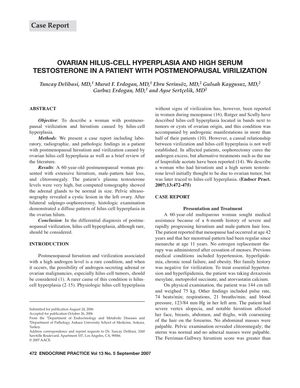Ovarian Hilus-Cell Hyperplasia and High Serum Testosterone in a Patient With Postmenopausal Virilization
January 2007
in “Endocrine Practice”

TLDR A woman's male-like symptoms and high testosterone were due to ovarian hilus-cell hyperplasia, which improved after surgery.
In 2007, a 60-year-old postmenopausal woman was reported to have developed severe hirsutism, male-pattern hair loss, and clitoromegaly due to ovarian hilus-cell hyperplasia. Her plasma testosterone levels were significantly elevated, although her adrenal glands were normal. A cystic lesion was found in her left ovary through a pelvic ultrasound. Following a bilateral salpingo-oophorectomy, histologic examination confirmed the diagnosis of hilus-cell hyperplasia. After the surgery, the woman's testosterone levels returned to normal, and her symptoms of hirsutism and virilism were greatly reduced. This case emphasized the importance of considering ovarian hilus-cell hyperplasia in the differential diagnosis for postmenopausal women presenting with virilization and high testosterone levels.
View this study on endocrinepractice.org →
Related

research Hirsutism and virilization
Excessive hair growth in women can be harmless or signal serious health issues, and treatment often includes medication and hair removal, with noticeable results after 3-6 months.